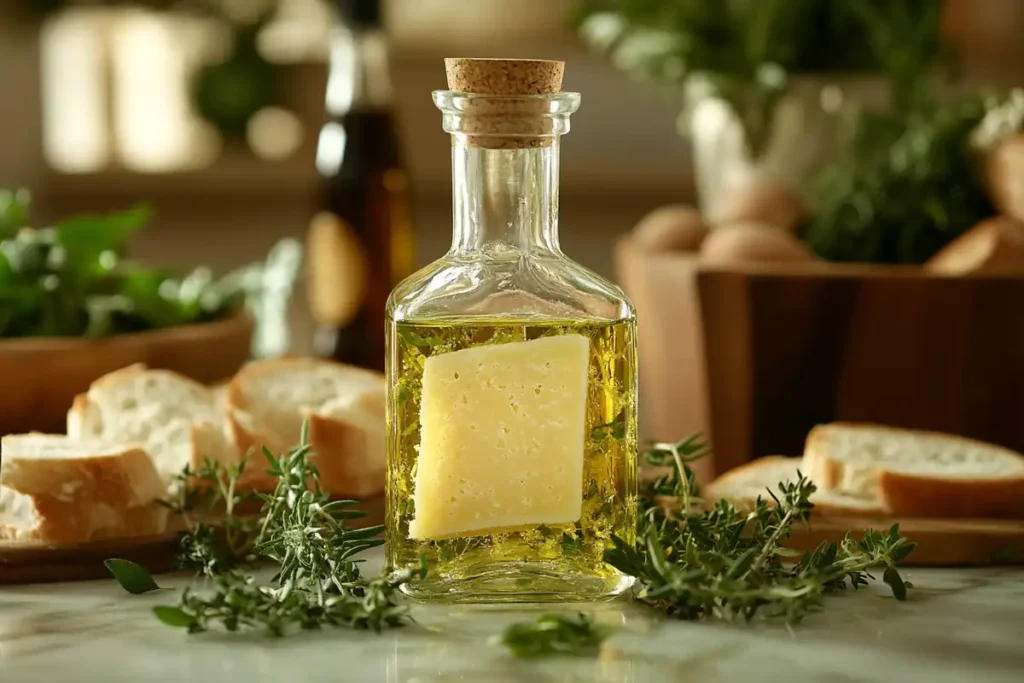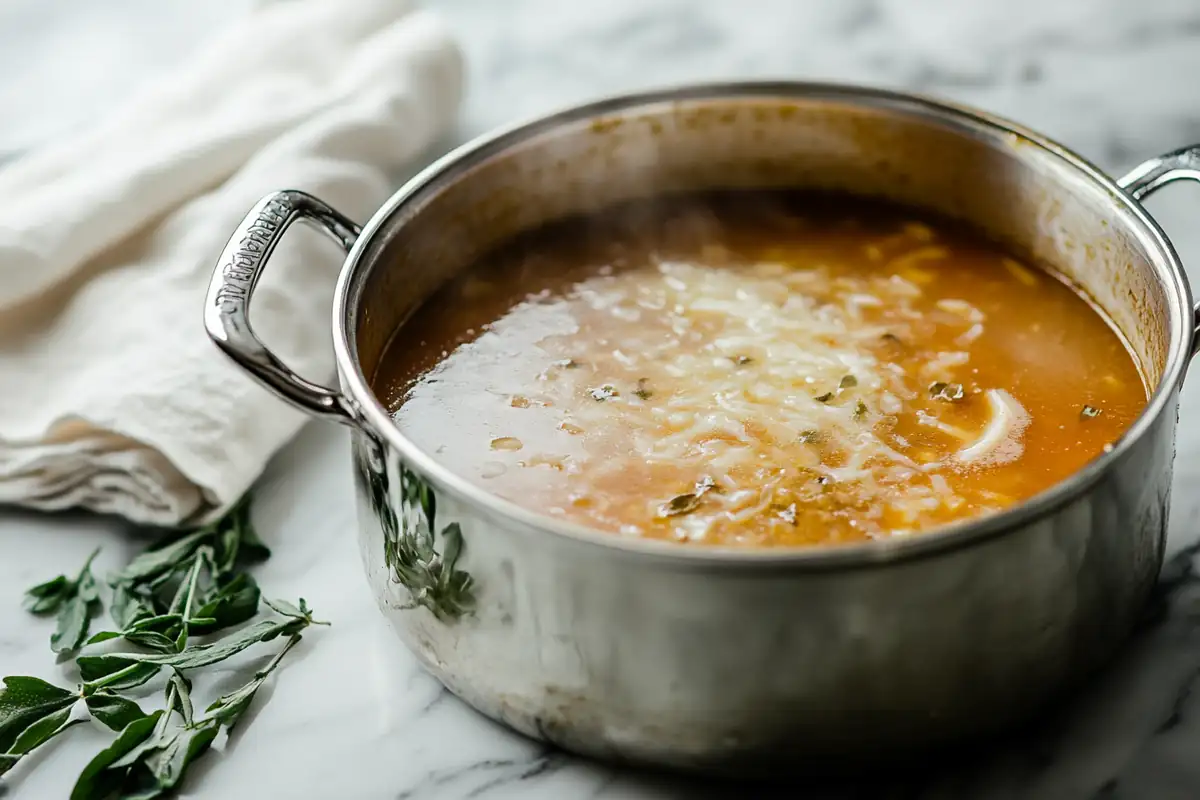Does Parmesan rind dissolve in soup? This article explores the use of Parmesan rinds in soups. Discover how they enhance flavor. Learn if they fully dissolve or not.
The Curious Case of Parmesan Rind in Soup
Many cooks wonder, does Parmesan rind dissolve in soup? It’s a common question. Therefore, let’s explore this topic. Parmesan rinds are often discarded. However, they can add great flavor to soups.
What is Parmesan Rind?
Parmesan rind is the hard outer layer of a Parmesan cheese wheel. Moreover, it’s mostly protein and fat. It is different from the edible part of the cheese. Indeed, it’s very dense. Additionally, the rind is a natural casing. Therefore, it protects the cheese during aging.
Why Use Parmesan Rind in Soup?
Using Parmesan rind in soup is a trick used by many chefs. Rinds contain concentrated cheese flavor. Therefore, they add richness to broths. Consequently, this makes them a valuable addition to many recipes. Furthermore, they offer a deeper flavor than regular cheese. Essentially, it’s a way to maximize flavor from one ingredient.
The Process: Does Parmesan Rind Dissolve?
The key question remains: does Parmesan rind dissolve in soup? The answer is not completely straightforward. While the rind won’t fully melt away, it does soften. Additionally, its flavor infuses into the liquid. Chiefly, the goal is flavor extraction rather than melting.
How Parmesan Rind Reacts to Heat
When Parmesan rind is added to hot soup, several things happen. The heat starts to break down the proteins within the rind. Furthermore, the fat begins to melt. As a result, the flavor is released into the soup. Specifically, the heat helps extract the savory essence. Essentially, the rind undergoes a transformation.
The Softening of Parmesan Rind
The texture of the Parmesan rind changes a great deal. Initially very hard, the heat softens it considerably. However, the rind itself does not disappear. It becomes pliable, but it will still be there, though it is now edible. In addition, the softening is a slow process. Accordingly, the longer it simmers, the softer it becomes.
Flavor Infusion is the Goal
The main purpose of using Parmesan rind in soup is to infuse flavor. Therefore, the slow release of cheesy goodness enriches the broth. Moreover, it adds a layer of umami to your cooking. Consequently, this enhances the overall flavor. Also, it adds a unique depth to the dish. Basically, it’s about getting the most flavor possible.
Does Parmesan Rind Dissolve? The Real Answer
So, does Parmesan rind dissolve? No, it does not fully dissolve. However, its essence does. The actual rind will remain in the pot. However, the heat has infused its flavor and softened the texture. Finally, it becomes something you can eat. Ultimately, it is a matter of understanding its behavior.
What Happens to the Rind?
After simmering, the Parmesan rind will be soft and pliable. Consequently, it will be different than when you started. It might appear slightly swollen. However, it will retain its shape. Specifically, it will be more manageable and edible. Indeed, it’s a good indicator of flavor extraction.
Removing or Eating the Softened Rind
Some people remove the softened rind before serving the soup. Alternatively, it can be enjoyed as part of the meal. Especially if you enjoy the texture. The rind will be soft and easy to eat. Nevertheless, the choice is based on individual preference. Furthermore, the softened rind is now quite palatable.
Ways to Use Parmesan Rind in Soup
There are many ways to use Parmesan rind in soup. It’s versatile and adds depth. Therefore, consider these options to make the best of your Parmesan rinds. Importantly, experimenting will help you find your favorites.
Adding it Early for Maximum Flavor
Add the Parmesan rind early in the cooking process. This allows maximum flavor infusion. For example, drop it in when adding the broth. Thus, it has a long time to work its magic. Specifically, it allows ample time for the flavors to blend. Accordingly, this is best practice.
Using it in Vegetable Broths
Parmesan rind is an excellent addition to vegetable broths. Accordingly, it provides a savory element that otherwise might be missing. The rind is particularly good in lentil and bean soups. Moreover, it helps add depth to otherwise mild flavors. Particularly, it’s a good addition for vegetarians.
Perfect for Brothy Soups

Brothy soups benefit most from Parmesan rind. The rind does not work in thick soups in the same way. Moreover, it needs the liquid to release flavor. Therefore, it is perfect for minestrone or chicken noodle soup. In short, soups with plenty of liquid are ideal. Subsequently, the broth will become the main carrier of flavor.
Other Ways to Include Parmesan Rind
Parmesan rinds also work in risotto and sauces. Furthermore, you could try it in stews and stocks. Indeed, the goal is the same, to extract flavor. Consequently, rinds become a very useful ingredient. Moreover, they bring richness to dishes. Ultimately, it makes your dishes taste better.
Best Practices When Using Parmesan Rind
Using Parmesan rind might seem simple, but there are best practices. Follow these tips for great results every time. After all, it’s important to get the most out of this flavorful addition. Indeed, proper usage is key for optimal flavor.
Choosing the Right Rind
Use rinds that are clean and free of mold. Furthermore, you should have stored them correctly. Good quality Parmesan rinds will give you the best flavor. So, always check before adding them to your pot. Specifically, avoid any rinds that appear damaged. Basically, the better the rind, the better the flavor.
Proper Storage of Parmesan Rind
Store Parmesan rinds in the fridge or freezer. Therefore, they will stay fresh until you need them. Store them in an airtight container to prevent drying. Thus, they will be ready for your next recipe. In particular, freezing is the best way to keep them long term. However, they keep well in the fridge for a few weeks.
How Much Rind to Use
A little Parmesan rind goes a long way. Therefore, one or two small pieces are enough for a large pot. Adding too much can overpower other flavors. Accordingly, moderation is key for a balanced taste. Specifically, start with less and add more if needed. Indeed, it’s easier to add flavor than to remove it.
Simmering Time for Best Flavor
Simmer Parmesan rind for at least 30 minutes to an hour. As a result, the flavor will infuse effectively. Longer simmering times can add even more flavor. Therefore, it depends on the recipe. Furthermore, a slow simmer is best for flavor extraction. Specifically, the low heat helps slowly break down the fats and proteins.
The Nutritional Benefits of Parmesan Rind (Indirectly)
While Parmesan rind itself is not eaten in large quantities, its benefits are indirect. The flavor it provides enhances the enjoyment of meals. Therefore, it can indirectly contribute to a balanced diet. Essentially, flavor is a key component of food satisfaction.
Enhancing Palatability of Healthy Soups
The umami provided by Parmesan rind makes vegetable soups more appealing. Consequently, people are more likely to eat them. Furthermore, this helps them get their necessary nutrients. Thus, it encourages the consumption of healthy foods. Basically, flavor is a key to healthy eating.
Reduced Need for Salt
Using Parmesan rind reduces the need for salt in soup. Rinds add flavor without the negative effects of too much sodium. Therefore, this can help people eat healthier soups. Moreover, this helps control sodium intake. Ultimately, it makes for a healthier dish.
A Source of Calcium and Protein
Even though rinds are not consumed directly, the flavor infusion provides trace amounts of calcium and protein. In conclusion, while not a main source, it does contribute a small bit. Additionally, it adds subtle nutritional value. Nevertheless, it is not a substitute for protein.
Why Your Parmesan Rind Doesn’t Dissolve
If you are wondering does Parmesan rind dissolve, remember it won’t. This section explains why. It’s important to understand the composition of the rind. This ensures proper usage in cooking. Specifically, understanding its structure is crucial.
The Composition of Parmesan Rind
Parmesan rind consists of dense proteins and fats. Specifically, these do not dissolve in water. Therefore, the heating process only softens it. The components do not break down enough to disappear. Furthermore, the dense nature resists dissolving. In essence, it’s not meant to dissolve.
The Difference Between Melting and Dissolving
Melting and dissolving are two different things. Parmesan cheese melts due to heat. However, dissolving means breaking down into individual molecules. Parmesan rind softens, but it does not dissolve. Thus, it’s important to understand the difference. Specifically, melting is a physical change, and dissolving is a chemical one.
The Hard Structure of Parmesan Rind
The dense structure of Parmesan rind makes it resistant to dissolving. Unlike softer cheeses, it maintains its shape. While it becomes pliable, the structure does not break down entirely. Basically, it’s the same reason bones don’t dissolve. Indeed, it’s a natural defense against complete breakdown.
Creative Uses for Parmesan Rind Besides Soup
While Parmesan rinds are fantastic in soup, their usefulness doesn’t stop there. Here are a few extra ways to use them. This helps you maximize their value. Indeed, Parmesan rind is a versatile ingredient.
Flavoring Risotto and Sauces
Add Parmesan rinds to risotto. They infuse the rice with amazing flavor. They work similarly in sauces. Furthermore, they add a deep, rich element. Specifically, a little rind can go a long way. Also, this adds depth and complexity to the flavors.
Enhancing Stocks and Broths
Parmesan rinds are great in stocks and broths. They boost the flavor of these cooking bases. The rinds can make a basic broth taste very special. Therefore, it is a great use for something you might throw away. Thus, it makes the most of the ingredient. Basically, they improve the overall flavor profile.
Infusing Olive Oil

Try infusing olive oil with Parmesan rind. The oil absorbs the cheese flavor, creating an amazing flavor. In addition, you can use this for salads and cooking. This is a creative use for the leftover rind. Furthermore, it’s a unique flavor to try in the kitchen. Basically, it’s a way to capture the essence of Parmesan.
Common Mistakes When Using Parmesan Rind
It’s helpful to know the common mistakes. Therefore, you can avoid them. Furthermore, this ensures that you get the most from the Parmesan rind. Importantly, avoiding these errors is crucial.
Adding Too Much Parmesan Rind
Adding too many Parmesan rinds can lead to an overpowering flavor. The taste could overwhelm other ingredients. Therefore, one or two small pieces are usually enough. Specifically, too much can be unpleasant. Essentially, start with a small amount.
Not Simmering Long Enough
Not simmering Parmesan rind long enough can result in less flavor. The rind needs time to release its essence. Simmer at least for 30 minutes. This ensures a good flavor release. Thus, patience is key. Specifically, it takes time to infuse the flavor properly.
Using Rinds That Are Too Old
Using rinds that are old or moldy can ruin the flavor. Ensure they are clean. The rind should also have been stored properly. Fresh rinds will always taste better. Therefore, always check the rind before use. Specifically, bad rinds can spoil the taste of your dish.
The Science Behind the Flavor Release
To understand Parmesan rind fully, understand the science. This helps appreciate how rinds flavor your food. It’s all about molecular interactions. Indeed, there’s a scientific explanation for all of this.
The Role of Glutamates
Parmesan cheese is rich in glutamates. This component provides umami. Moreover, heat releases these compounds from the rind. Therefore, this adds depth and savoriness to the soup. Specifically, glutamates enhance savory flavors. Accordingly, this contributes to the delicious taste.
The Breakdown of Fats and Proteins
Heat breaks down the proteins and fats in the Parmesan rind. These break-down products contribute to the flavor profile. The process makes the soup taste complex and very delicious. Thus, the breakdown enhances the taste. Essentially, it’s a flavor transformation.
How Molecules Move in Liquid
In a liquid environment, flavor molecules move easily. Thus, the molecules from the rind move into the soup. Consequently, the flavor infuses the entire broth. Specifically, liquid acts as a perfect medium. Indeed, it’s a key element to this technique.
Exploring Different Types of Parmesan and Their Rinds
There are a few different varieties of Parmesan cheese. Each of these has its own distinct flavor and rind. Furthermore, each rind will behave slightly different in your cooking.
Understanding the Differences
Parmigiano-Reggiano is the authentic Parmesan from Italy. Accordingly, it is the most flavorful. Other versions may have less flavor. Moreover, the age of the Parmesan affects flavor, too.
How Aging Affects the Rind
The Parmesan aging process greatly affects the rind. Rinds from older cheese will be denser. Thus, these also have a more intense flavor. Also, the rind’s texture and hardness increase with age.
Tasting Notes of Different Rinds
Experiment with rinds from different aged cheese. You can try younger Parmesan for a mild flavor. Additionally, older Parmesan provides a sharper taste. Moreover, the flavors can vary greatly.
Storing and Handling Parmesan Rinds for Future Use
Properly storing and handling your Parmesan rinds will help you make the most of them. This ensures they maintain their flavor. Furthermore, you can keep them for future cooking endeavors.
Freezing Parmesan Rinds
Freezing is the best method for long-term storage. Place the rinds in an airtight freezer bag. They will keep for several months. Also, they are ready whenever you need them.
Refrigerating Parmesan Rinds
If you plan to use them soon, you can store them in the fridge. Use an airtight container. They should be used within a few weeks. Moreover, proper refrigeration ensures freshness.
Ensuring Rinds Are Dry Before Storage
Before freezing or refrigerating, make sure your rinds are dry. This prevents mold. Use a paper towel. Thus, you can ensure your rinds last longer.
Conclusion: The Unique Use of Parmesan Rind
In conclusion, does Parmesan rind dissolve in soup? No, not entirely. However, it does enhance flavor. The softened rind becomes edible and delicious. It’s a great tip for any cook, whether an expert or a beginner. Specifically, it is about flavor infusion rather than melting.
A Sustainable Cooking Tip
Using Parmesan rind is a very sustainable cooking tip. It is a way to reduce food waste. Instead of throwing them away, you can get great flavor. So, Parmesan rind is your secret ingredient. Ultimately, it’s a good way to save money.
Exploring Flavors with Parmesan Rind
Using Parmesan rind is an example of exploring flavors. This technique transforms simple dishes. Therefore, you should start using your rinds. They’re a secret weapon you should not waste. Also, you will expand your culinary horizons. Indeed, it’s a great technique to have.

